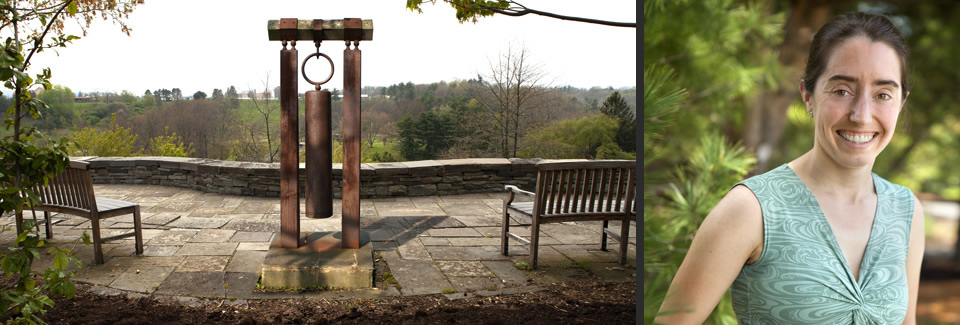
Class of 2012
Molly Yazwinski’s voice gets soft, and her face lights up as she remembers Alaskan nights spent mushing in the moonlight.
“It’s hard to explain to people what it’s like to run a team of dogs,” says Yazwinski ’12. “You are out in beautiful country, feeling that you can get away from everything. The dogs—the most amazing athletes ever—are happy. At 40-below you see their breath rise, hear the crunch of the snow.”
Animals, and dogs in particular, have always been a part of Yazwinski’s life. She grew up on a dairy farm in Deerfield, Massachusetts, had her own flock of sheep and “hung along” with her mom who bred, raised, and trained border collies in obedience. Since her mother raced sled dogs in New England, Yazwinski even had the opportunity to be on the finish lines of the Iditarod in 1987, the year the famous American musher, the late Susan Butcher, and her team of dogs won the famed 1,100-mile race from Anchorage to Nome, Alaska.
Later, as an undergraduate student at Middlebury College in Middlebury, Vermont, Yazwinski combined her love of animals with her studies, majoring in biology and environmental science. But, after graduation, she wasn’t ready for veterinary school.
“I knew I needed to be away from studying for a while, so I went to Alaska,” Yazwinski recalls.
So Butcher, a close family friend, and her sledding partner, David Monson, put Yazwinski to work at their dog kennels, Trail Breaker Kennels, in Fairbanks, Alaska. For four years she worked at the kennels as a dog handler, and taught vacationers aboard the Athabascan Indian Village riverboat, Discovery, about dog sledding and racing.
Before she began her study of veterinary medicine at Cornell, Yazwinski spent several years working and mushing dogs in Alaska. In 2008, she ran the Iditarod, scratching at the last checkpoint, with a team of 16 of Butcher’s and Monson’s dogs.
“There’s the adrenaline rush, an adventure around every corner,” Yazwinski says. “So, I’ll just have to go back up and do it again.”
Yazwinski began studying veterinary medicine, production medicine in particular, at Cornell in 2009. Attracted to the school for the opportunities it provided to closely work with faculty experts, Yazwinski soon connected with Joseph Wakshlag, MS, DVM, PhD, assistant professor of clinical nutrition at the College of Veterinary Medicine. He is also a musher.
In collaboration with Wakshlag, Yazwinski designed an International Sled Dog Veterinary Medical Association (ISDVMA)–sponsored study that put her back on the racing trails of Alaska with sled dogs again. The study—patterned after those done with human ultra-endurance athletes—examines the relationship between nutrition, stress, and inflammatory response to exercise.
Yazwinski elicited the cooperation of mushers participating in the 2011 Yukon Quest, an annual 1,000-mile race between Whitehorse, Yukon Territory, and Fairbanks. The mushers recorded what they fed the dogs and gave Yazwinski samples of the food so she could analyze the nutrient value and the dogs’ energy intake. During the race she periodically drew blood to gain a variety of information including markers of inflammation. The results will be available in her first published paper.
Throughout her years at Cornell, Yazwinski couldn’t stay away from Alaska. During the summer after her second year studying veterinary medicine, she returned to Alaska to work for the University of Fairbanks Reindeer Research Program. The program helps native herders around Nome, Alaska, do their roundup at the end of July by driving the herd—on foot—down into the low country where the animals are tagged, dewormed, and given brucellosis vaccinations. Samples are also taken for ongoing studies involving the herpes virus in reindeer. For Yazwinski, being around what she refers to as “lightly built” creatures was memorable.
“Their feet click when they walk so when you are working with a whole herd of them it’s ‘click, click, click,’” Yazwinski says. “It took us days to collect this one herd. We had to bring them down and run them a few miles through dense brush, eight feet high. Often you couldn’t see them, just dust and a flash of their antlers, but could tell they were there by the clicking.”
She’s keeping an open mind toward what the future holds. Yazwinski is looking for a mixed practice where she can be mentored and have the opportunity to do “a little bit of everything,” she says, but returning to her family’s farm is another possibility. Raising sheepdogs appeals, too. And, of course, being back on the trail with her own dogsled team—even a little one of just eight dogs—would make her happy.
“Your basic DVM degree is fairly broad,” she says, “so there’s a world of possibilities."





